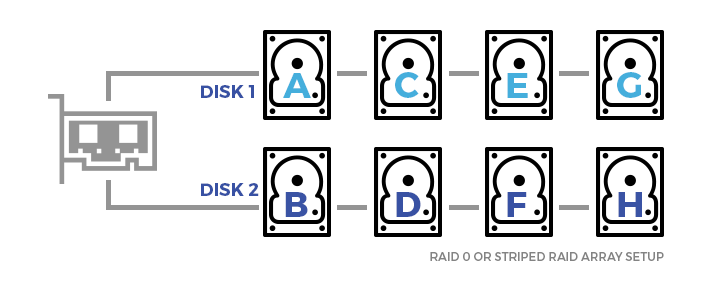RAID 0 or Striped RAID Arrays – How Do they Work
RAID 0 is not a true RAID type, the term RAID stands for Redundant Array of Inexpensive Disks (or Redundant Array of Inexpensive Drives as it was originally coined) and as RAID 0 has no redundancy it is not considered a true RAID type.
In RAID 0 data is written to the drives using a method known as striping, whereby a small chunk of the data being written at any one time is written simultaneously to each of the hard drives that make up the array, this is shown below:

A RAID 0 array can consist of many drives, there must be a minimum of two devices for the array to work but there is no upper limit of drives other than those imposed by the RAID controller/software. It must be warned, however, that increasing the number of drives in the array leads to a less and less reliable set. In fact the probability of failure is roughly inversely proportional to the number of drives that make up the array. So a volume containing two hard disk drives would be almost twice as likely to fail as a single hard disk drive operating alone.
So why would anyone use a striped array?
Well, the act of striping the data improves throughput in most cases by using the full bandwidth available on each of the member devices in the array. So if two drives were configured into this type of array you could theoretically double the throughput, however, this is rarely the case in practice and depends very much on the size and type of data being accessed as well as the ability and quality of the controller.
RAID 0 alone is not recommended for critical data storage, certainly not without measures being taken to ensure that data stored on the array is securely backed up to numerous other media. In the real world performance gains are not large enough to warrant the use of a RAID 0 array outside of the realm of video editing, high performance gaming, etc.
Data Recovery
Should you have been unlucky enough to have experienced data loss on a RAID 0 array, it is important that you seek advise on how to proceed immediately. Disparity data recovery can offer free advise on how to prevent further data loss, and a competitive quote for the subsequent hard disk repair work that may be needed to successfully get you back up and running in the quickest possible time with the minimum of fuss and importantly the minimum of downtime for your business.
Our services can help you to
- Recover your lost data
- Return your system to a bootable/useable state
- Implement appropriate backup solutions
- Advise on ways of securing your data against further loss
- Technicians are available to talk you through your data recovery options now, call on 0800 999 3282
- Or alternatively Contact us via our support page and we will call you straight back
Benefits of Using Striped Arrays
- Faster data access
- Storage capacity = sum of the member disks (assuming they are of equal size)
- Can be achieved in software by most modern operating systems, from NT versions of Microsoft Windows, MAC OS X and Linux/Unix
- Dedicated hardware is cheap and normally supports other array types, at least RAID 1 in most cases
Drawbacks
- No parity or other fault tolerance
- Failure probability is directly related to the number of drives in the array, the more there are, the more likely a failure will occur resulting in total data loss.
- Data Recovery can be expensive especially if the array is large and numerous drives have failed

